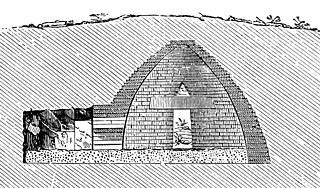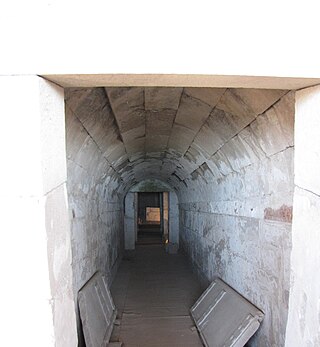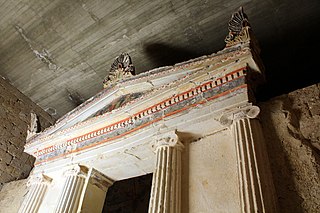
At works to recover clay, two Macedonian tombs were discovered north of Katerini.

At works to recover clay, two Macedonian tombs were discovered north of Katerini.
The graves are located approximately 3.7 km northeast of the center of Katerini between the National Road 1, the main connection Athens - Thessaloniki, and the Highway 1, immediately north of the junction Vória Kateríni (Katerini-North, Greek: Βόρεια Κατερίνη). [1]

Already in the late 1960s, a destroyed kiln and building remains had been discovered. [2] Other structures were destroyed by dredging, while parts of a burial chamber were noticed. [3] The tomb A is one of the earliest known examples of Macedonian tombs. [4] Because of the design the grave is regarded as a transitional form from the cist graves to the Macedonian tombs. The excavations were carried out in May 1977. The discovery of a coin from the time Amyntas III allows dating of the tomb in the 2nd quarter of the 4th century BC. [5] Both tombs were built from precisely manufactured limestone monoliths, plastered and painted inside. The graves were covered flat, they have neither access (Dromos) nor the usual vaulted ceiling. In both graves, the stone roof construction was partially removed, so that one has a good view from above. Access to the graves is not possible. A metal cover protects the structures from weathering.
The western grave has a pre-chamber and the actual burial chamber. The two chambers were separated by a double-winged marble door, which is completely preserved. The door was made, as in the neighboring Macedonian Tombs at Korinos, as a faux wooden door. Thus, iron bands and their attachment are mimicked. The floor is covered with stone slabs. The plaster of the interior walls is painted following the pattern of the smaller tomb. In the burial chamber are the remains of a stone couch (Kline), on which the deceased was buried.
To protect the marble doors from falling over, they are supported by wooden struts and metal bars.
The smaller, eastern grave is designed as a single-chamber grave. It was adorned by a two-tone painting. The plaster of the upper layer of the monolithic masonry is painted with yellow paint, the plaster of the underlying cuboid was decorated with red paint. The floor is laid out with stone plates.

A beehive tomb, also known as a tholos tomb, is a burial structure characterized by its false dome created by corbelling, the superposition of successively smaller rings of mudbricks or, more often, stones. The resulting structure resembles a beehive, hence the traditional English name.

Vergina is a small town in Northern Greece, part of Veria municipality in Imathia, Central Macedonia. Vergina was established in 1922 in the aftermath of the population exchanges after the Treaty of Lausanne and was a separate municipality until 2011, when it was merged with Veroia under the Kallikratis Plan.

Christos Tsountas was a Greek classical archaeologist. He is considered a pioneer of Greek archaeology and has been called "the first and most eminent Greek prehistorian".

A Mycenaean chamber tomb is the type of chamber tomb that was built in Mycenaean Greece. Mycenaean chamber tombs originated in Messenia at the end of the Middle Helladic period, and were built and used throughout the Late Bronze Age across the Aegean area.

The Archaeological Museum of Dion is a museum in Dion in the Pieria regional unit of Central Macedonia, Greece.
Wall Painting in Turkey often reflects influences from the eastern and western styles and subject matters that date back to the Neolithic Age as the region has been a crossroads between Europe and the Middle East.

The Illyrian Tombs of Selca e Poshtme are located near the town of Pogradec in Albania near the village of Selcë e Poshtme. On the right bank of the river Shkumbin at an elevation of 1040 m above sea level, lie the remains of the ancient city of Pelion and the accompanying necropolis. The Roman Via Egnatia led past it towards Thessaloniki. Though there are traces of human activity in Neolithic times, the settlement proper dates to the Iron Age through to the Illyrian urban period, and reached its height under settlement by the Illyrian tribe of Enchele in the later Iron Age and was also occupied in the Roman period as traces of a municipal building show. From the 4th to 1st centuries BC the city was the royal residence of Illyrian kings and therefore, also probably an important political and economic centre. In 1996, Albania included the Royal tombs of Selca e Poshtme in the UNESCO World heritage list of proposals.
Panagiotis V. Faklaris is a Greek archaeologist, professor of classical archaeology and excavator of the acropolis and the walls of Vergina. Main fields of specialization: topography of ancient Macedonia, topography of ancient Kynouria, arms and armour, horse harnesses, ancient Greek daily life, metal finds, Greek mythology. Studied archaeology at the Aristotle University of Thessaloniki and the University of Cambridge UK. Born in Arcadia, Greece, April 1947. Assistant (1978–1992) of the famous Greek archaeology professor Manolis Andronikos. Member of the Athens Archaeological Society since 1986. Member of the Greek Folklore Society since 1977. Founding member of the Association for the Study of Ancient Greek Technology (EMAET).EMAET Member of the Historical and Epigraphical Studies Society. Member of the Peloponnesian Studies Society. Εταιρεία Πελοποννησιακών Σπουδών Founding member of the Arcadian Academy.

Ancient Greek funerary practices are attested widely in literature, the archaeological record, and in ancient Greek art. Finds associated with burials are an important source for ancient Greek culture, though Greek funerals are not as well documented as those of the ancient Romans.

The Kasta Tomb, also known as the Amphipolis Tomb, is the largest ancient tumulus ever discovered in Greece, and by comparison dwarfs that of Philip II of Macedon, father of Alexander the Great, in Vergina.

The Tomb of the Unknown Soldier is a war memorial located in Syntagma Square in Athens, in front of the Old Royal Palace. It is a cenotaph dedicated to the Greek soldiers killed during war. It was sculpted between 1930 and 1932 by sculptor Fokion Rok.

In the middle of the 19th century, an important Macedonian tomb, now known as Tomb A, was discovered near the Greek village of Korinos, at the site of ancient Pydna. In 1991 a second, smaller grave was discovered and excavated.

This is a reflection of the main historical events in Pieria (Πιερία), Central Macedonia.
There are some Macedonian tombs and the necropolises of Pydna around ancient Pydna and beside the ancient road from Methone in the north to Dion in the south. The oldest tombs are from the Bronze Age; the youngest are from the early Christian period. Smaller tumuli have eroded over time and are no longer visible. Most excavations have had to be carried out to save the sites. The finds in both areas show a shrinking population during the second Greek colonization.
The Pigi Athinas is an archaeological site at the eastern foot of Mount Olympus, near the village of Platamonas.
Pigi Artemidos is a Bronze Age settlement.

The Tomb of Judgement, also known as the Great Tomb of Lefkadia is an ancient Macedonian tomb of the Hellenistic period in Mieza, noted for its monumental painted facade. It was probably built at the beginning of the third century BC.

The Tomb of the Palmettes, sometimes known as the Rhomiopoulou Tomb, is an ancient Macedonian tomb of the Hellenistic period in Mieza, Macedonia, Greece, noted for the quality of its painted decoration. It was built in the first half of the third century BC.
The Tomb of Macridy Bey (Greek: Τάφος Μακρίδη Μπέη, romanized: tafos makridi bei, also known as the Tomb of Langadas, is an ancient Macedonian tomb of the Classical or early Hellenistic period, on the site of ancient Lete, modern Derveni between Thessaloniki and Langadas, in Central Macedonia, Greece. A number of cist graves and a single chamber tomb are located in the vicinity. The structure seems to date to the late fourth or early third century BCE.

Georgios Pentzikis was a Greek chieftain of the Macedonian Struggle.